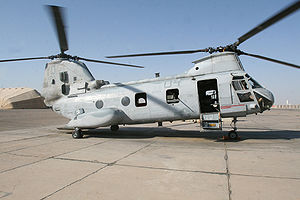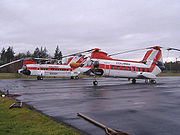
Tandem rotor
Encyclopedia

Helicopter
A helicopter is a type of rotorcraft in which lift and thrust are supplied by one or more engine-driven rotors. This allows the helicopter to take off and land vertically, to hover, and to fly forwards, backwards, and laterally...
s have two large horizontal
Horizontal plane
In geometry, physics, astronomy, geography, and related sciences, a plane is said to be horizontal at a given point if it is perpendicular to the gradient of the gravity field at that point— in other words, if apparent gravity makes a plumb bob hang perpendicular to the plane at that point.In...
rotor
Helicopter rotor
A helicopter main rotor or rotor system is a type of fan that is used to generate both the aerodynamic lift force that supports the weight of the helicopter, and thrust which counteracts aerodynamic drag in forward flight...
assemblies mounted one in front of the other. Currently this configuration is mainly used for large cargo helicopters.
Single rotor helicopters need a tail rotor
Tail rotor
The tail rotor, or anti-torque rotor, is a smaller rotor mounted so that it rotates vertically or near-vertically at the end of the tail of a traditional single-rotor helicopter. The tail rotor's position and distance from the center of gravity allow it to develop thrust in the same direction as...
to neutralize the yawing
Aircraft principal axes
An aircraft in flight is free to rotate in three dimensions: pitch, nose up or down about an axis running from wing to wing), yaw, nose left or right about an axis running up and down; and roll, rotation about an axis running from nose to tail. The axes are alternatively designated as lateral,...
moment produced by the single large rotor. Tandem rotor helicopters, however, use counter-rotating rotors, with each canceling out the other's torque. Therefore all of the power from the engines can be used for lift, whereas a single rotor helicopter uses power to counter the torque.
Advantages of the tandem-rotor system are a larger center-of-gravity range and good longitudinal stability. Disadvantages of the tandem-rotor system are a complex transmission, and the need for two large rotors.
The two rotors are linked by a transmission that ensures the rotors are synchronized and do not hit each other, even during an engine failure.
Tandem rotor designs achieve yaw by applying opposite left and right cyclic
Helicopter flight controls
A helicopter pilot manipulates the helicopter flight controls in order to achieve controlled aerodynamic flight. The changes made to the flight controls are transmitted mechanically to the rotor, producing aerodynamic effects on the helicopter's rotor blades which allow the helicopter to be...
to each rotor, effectively pulling both ends of the helicopter in opposite directions. To achieve pitch, opposite collective is applied to each rotor; decreasing the lift produced at one end, while increasing lift at the opposite end, effectively tilting the helicopter forward or back.
Tandem rotor aerodynamics is a complex subject. Tandem rotor helicopters have the advantage of being able to hold more weight with shorter blades, since there are two sets. However, the rear rotor works in the aerodynamic shadow of the front rotor, which reduces its efficiency. This loss can be minimized by increasing the distance between the two rotor hubs, and by elevating one hub over the other. Tandem rotor helicopters tend to have a lower disk loading
Disk loading
In fluid dynamics, disk loading or disc loading is the average pressure change across an actuator disk, such as an airscrew. Airscrews with a relatively low disk loading are typically called rotors, including helicopter main rotors and tail rotors; propellers typically have a higher disk...
than single rotor helicopters.
Tandem rotor helicopters typically require less power to hover and achieve low speed flight as compared to single rotor helicopters. Both configurations typically require the same power to achieve high speed flight.
List of some tandem rotor helicopters


- HRP RescuerHRP Rescuer|-See also:-External links:* * *...
(1945) - Piasecki PV-14 (1948)
- HERC Jov-3Jovair JOV-3The Jovanovich JOV-3 was a two-seat tandem helicopter originally designed by Drago Jovanovich at the Helicopter Engineering Research Corporation . When McCulloch Aircraft Corporation purchased HERC they improved the design for prospective military use and it became the McCulloch MC-4.-External...
(1948) - Piasecki H-21 (1949)
- McCulloch MC-4McCulloch H-30|-References:* John Andrade, U.S.Military Aircraft Designations and Serials since 1909, Midland Counties Publications, 1979, ISBN 0 904597 22 9 * The Illustrated Encyclopedia of Aircraft , 1985, Orbis Publishing, Page 2213/2214....
(1951) - Piasecki H-25/HUP Retriever (1952)
- Yakovlev Yak-24 (1952)
- Bristol BelvedereBristol BelvedereThe Bristol Type 192 Belvedere is a British twin-engine, tandem rotor military helicopter built by the Bristol Aeroplane Company. It was designed for a variety of transport roles including troop transport, supply dropping and casualty evacuation...
(1952) - Piasecki H-16Piasecki H-16-External links:* *...
(1953) - Piasecki H-21 (1953)
- Bell HSLBell HSL-References:NotesBibliography* Andrade, John M. U.S.Military Aircraft Designation and Serials since 1909. Leicester, UK: Midland Counties Publications, 1979. ISBN 0-904597-22-9....
(1953) - Boeing Vertol 107-II (1958)
- CH-46 Sea KnightCH-46 Sea KnightThe Boeing Vertol CH-46 Sea Knight is a medium-lift tandem rotor transport helicopter, used by the United States Marine Corps to provide all-weather, day-or-night assault transport of combat troops, supplies and equipment. Assault Support is its primary function, and the movement of supplies and...
(1960) - CH-47 ChinookCH-47 ChinookThe Boeing CH-47 Chinook is an American twin-engine, tandem rotor heavy-lift helicopter. Its top speed of 170 knots is faster than contemporary utility and attack helicopters of the 1960s...
(1961) - Jovair Sedan 4AMcCulloch H-30|-References:* John Andrade, U.S.Military Aircraft Designations and Serials since 1909, Midland Counties Publications, 1979, ISBN 0 904597 22 9 * The Illustrated Encyclopedia of Aircraft , 1985, Orbis Publishing, Page 2213/2214....
(1963) - Fliper Beta 200 (1966)
- Fliper Beta 400 (1967)
- Boeing Vertol XCH-62Boeing Vertol XCH-62|-See also:-References:* Wilson, Michael. "". Flight International, 13 July 1972, pp. 44c–47.-External links:* * * at Friends of The Helicopter Museum...
(1970s - not completed) - Boeing Model 234 (1981)
- Boeing Model 360Boeing Model 360-External links:* * * , NASA, March 1989, Retrieved Dec 12, 2008*...
(1987)
See also
- Coaxial rotors
- Intermeshing rotorsIntermeshing rotorsIntermeshing rotors on a helicopter are a set of two rotors turning in opposite directions, with each rotor mast mounted on the helicopter with a slight angle to the other, in a transversely symmetrical manner, so that the blades intermesh without colliding. The arrangement allows the helicopter to...
- RotorcraftRotorcraftA rotorcraft or rotary wing aircraft is a heavier-than-air flying machine that uses lift generated by wings, called rotor blades, that revolve around a mast. Several rotor blades mounted to a single mast are referred to as a rotor. The International Civil Aviation Organization defines a rotorcraft...
- Transverse rotorsTransverse rotorsTransverse rotor rotorcraft have two large horizontal rotor assemblies mounted side by side.Single rotor helicopters need a tail rotor to neutralize the twisting moment produced by the single large rotor. Tandem rotor helicopters, however, use counter-rotating rotors, with each canceling out the...
- TiltrotorTiltrotorA tiltrotor is an aircraft which uses a pair or more of powered rotors mounted on rotating shafts or nacelles at the end of a fixed wing for lift and propulsion, and combines the vertical lift capability of a helicopter with the speed and range of a conventional fixed-wing aircraft...

